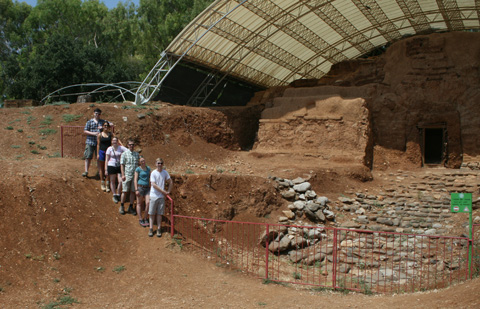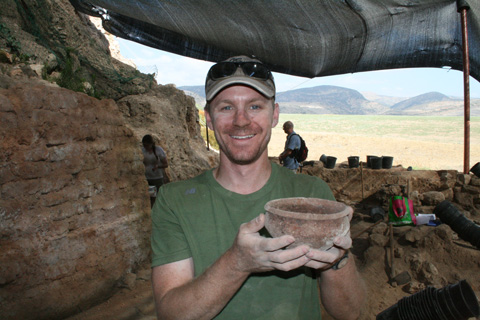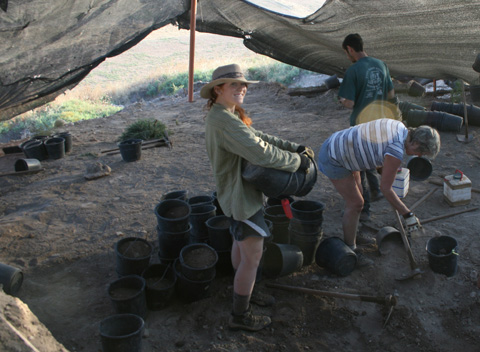“I felt empowered by the first break into the ground. It really felt like I was uncovering the past through my efforts,” says Megan Norris ’14, who spent a month on a dig in Israel in summer 2013.
“Every part of the work during the dig felt magical. It was exciting to move dirt that had such a rich history associated with it—even though really it was only dirt. The magnitude of the importance of the dig was not always apparent, especially during long sweaty and hot hours, but at the end of the day/dig is all felt like a surreal dream.
“The site of Tel Hazor was one of the most amazing places to be and visit!” says Norris, who majored in Anthropology with minors in Chemistry and World Religions. She also participated in the College of Arts & Sciences Scholars Program.
At Tel Hazor in northern Israel, students in the Archaeology in Israel study abroad program were instructed in archaeological procedures and dug with Dr. Cory Crawford, Assistant Professor of Classics & World Religions, and the site supervisors.

Ohio University students in front of a mud brick city gate at Tel Dan in Northern Israel. At almost 4,000 years old, it is the largest intact archway in the world. From left: Zach Pastor Poe, Josh Baron, Johnny Yochum, Taylor Greuser, and Megan Norris.
Day 1 on the Dig
“Day 1 on the dig was really amazing,” says Norris, citing it as the most powerful moment of the experience in the summer of 2013.
“I kept a blog while there as a journal, and reflecting on my entry that day, I wrote about how enjoyable getting to play in the dirt is!”
“It was surreal, and the only way I can even attempt to relate that feeling to someone else is to let them also interact with the small sherds of pottery we were able to take with us as souvenirs from the dig. (Note: these are very insignificant pieces, just tiny broken parts of a whole.) Having them allows the tiniest aspect of interacting with the past come alive for whomever is holding the pieces.
“Dirty is an interesting word; the dig was dirty!” says Norris. “You were covered each day with dirt stuck to your face, arms, and any exposed skin. I would not recommend shorts for an archaeology dig. I still have sand caked to the inside of hiking boots that I wore during the dig.
Norris describes the living conditions as similar to “cabins you would rent for a hiking or camping trip.” The food, she says, was all homemade on the Kibbutz. And the camaraderie was easy.
“From offering a hand with a heavy bucket, bringing the water jug when someone looked particularly parched, to just conversations with others from different cultures over lunch or dinner, it was easy to form friendships. A lot of the other diggers had been to the site many times before, and they were always sharing advice. I learned a lot from the older members of the dig, which was an added bonus to the whole experience!”

Dr. Cory Crawford, Assistant Professor of Biblical Studies, shows a Bronze Age ceremonial cooking pot he excavated in the Canaanite palace at Tel Hazor.
Culture and Religion, Past and Present
Norris took advantage of opportunities to learn about current religious and cultural issues while digging into the past.
She engaged the Israeli diggers in conversations about religion and the country, and they were receptive to her interest.
“In many ways, Israel continues to carry on long-standing traditions that make the religious and cultural issues a continuum from the past. Our country doesn’t have a history like that, and so Israel is amazing in its richness of cultural depth,” Norris says.
“The coolest aspect I learned about was actual more of a personal experience for me. Before going to Israel, I never knew about the traditions of pilgrims going there. Obviously, I knew Jerusalem was a hotspot stop for pilgrimages of many faiths, but I never would have guessed what some sects of Christianity return home with from the Holy Land. While digging at Hazor, I learned from a visiting professor about the tradition of some Christian pilgrimages getting tattoos in the Old City of Jerusalem. He told me about this because apparently my wrist tattoo of the Jerusalem Cross is the same symbol that these pilgrimages obtain in the city! He thought I got my tattoo while visiting Jerusalem prior to the dig. it was really interesting to learn about a cultural aspect I never would have thought to look into myself.”
She also enjoyed a conversation with her site supervisor, who is an archaeologist. “She told me how digging, for her, was the only way she could interact with people of the past, and they were really her passion. It was neat to see the passion through her and realize that archaeology is a significant contribution to the world as whole. The information gathered from a dig contributes to betterment of many societies through various ways.”
Israel, Nothing Short of Magical
“Israel, the country, is nothing short of magical,” Norris says.
The cities in Israel (Jerusalem and Tel Aviv in particular) were very similar to other metropolis’ but unique, they had character which made you feel transported to another time.
“Having spent the first week of our trip in Jerusalem and exploring southern Israel, my expectations of climate were met: desert, arid, sunny. But when we traveled north for the dig, I found Israel to also contain this lush environment. The Banias (waterfall) was spectacular and I could not believe that we were still in the desert of the Middle East.
About Archaeology in Israel
The Archaeological in Israel program is a hands-on introduction to archaeology as well as to the land of Israel and its historical, religious and cultural treasures. It is centered around participation in an archaeological expedition to Tel Hazor to help excavate Biblical-period palaces and other architecture. Hazor was the largest city in ancient Israel/Canaan and is located just north of the Sea of Galilee.
Students spent the first week in Jerusalem touring sites like the Temple Mount, the Dead Sea, and Megiddo, before transferring to the excavation.
In addition to instruction in archaeological field methods, participants explore the relationship of archaeology to the Bible and to the history of ancient and modern Israel/Palestine, while living and working closely with people from across the world.
This program is open to Ohio University undergraduates with an interest in archaeology.



















One Comment